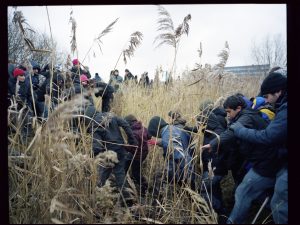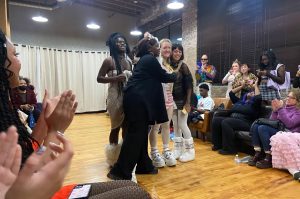
With hands clasped behind them, the cadets line up in formation. On the gym floor of Air Force Academy High School, students report to the cadet chief master sergeant, and he reports to the cadet commanding officer. They turn as a squadron to face the American flag and say the pledge of allegiance.
In the spring of 2013 the first senior class will graduate from AFAHS located in Armour Square on the Near South Side of Chicago.
In 1999, Chicago opened the first public high school military academy in the United States. The model proved successful, and Air Force Academy High School became the sixth and newest military model school in the Chicago Public School system.
There is a loose association with the United States military. Mainly these programs are college prep schools. The Air Force pays some of the salaries of the JROTC instructors and provides some of the supplies and uniforms that students wear to class.
The military model implements more structure than regular high schools. Cadets don’t show up to class, they report to class. There is a uniform inspection and role call before each lesson. They request permission to enter and leave a room. Students are required to complete four years of JROTC instruction. Drilling, leadership skills and military history are part of the training.
“We have to do all the same stuff they do in the Air force,” said Daina Smith, a freshmen who wants to be a pilot. There is an excitement from the students about the military aspects of the curriculum. They like the uniforms and earning rank and drilling. Yet most are not interested in a military career.
Cadets here have a variety of goals. One said he wanted to go to Columbia College Chicago to study graphic arts. Senior Abigail Jaimes said she wanted to be a nurse.
Freshmen take field trips to the Adler Planetarium every five weeks as part of their physics class. The planetarium also offers internships and volunteer opportunities to students. Advanced astronomy, and aerospace engineering are offered to upper-class men. The Academy is also in partnership with Lewis University for advanced course offerings and are starting after school aviation instruction.
The principal Captain Yashika Tippits-Eggleston, who is a retired army officer credits the teachers and on going collaboration amongst the staff, parents and students for the success of the school. “We use the data to see where our low points are and that drives the programming, drives the strategies,” Tippits-Eggleston said.
So far that work is paying off. In the schools first three years it has seen better than 90 percent attendance according to Tippits-Eggleston. Standardized test scores provided by the CPS for 2012 show that Air Force Academy ranks 32nd out 138 schools in top ACT scores and 28th in PSAE scores. They are ranked 5th amongst all Chicago Public Schools in freshman On Track Rates which stands now at 97 percent. The On Track Rate is considered the best indicator of student success used by CPS.
Cadet Brigadier General James Hejna is the highest ranking cadet amongst the 21 JROTC programs in Chicago.
Air Force Academy is highly selective. According to Tippet-Eggleston there are 700 to 800 applications each year for the 150 freshmen spots available. Being accepted into the school is based on a student’s past academic performance as well as two written essays and a short survey.
Chicago Military Academies are located mostly in minority neighborhoods such as Bronzeville and East Garfield Park. According to CPS, 85.4 percent of the students at Air Force Academy High School are from low income households and 86 percent of the students are minorities. These statistics are characteristic of the other military academies in the CPS.
Critics have said the military academies in Chicago target lower-income neighborhoods to fill the ranks of the armed services. Tippets-Eggleston, who was the principal at Carver Military Academy on the Far South Side before coming to Air Force Academy said: “I thought that was an issue that was dealt with a long time ago.” She went on to say that more students from non-military schools go into the service after high school than do students from the six military academies.
The cadets at Air Force are universally enthusiastic about their experience. “The staff is amazing, the best in Chicago,” said Cadet Staff Sgt. Jameson Parker.
Talking over one another to elaborate on a point, or to correct a fellow cadet they spoke about life at the school and how it’s different from their neighborhood schools. “In a regular high school if the students get rowdy they don’t care at all, but here the teachers care a lot,” said Cadet Staff Sgt. Jakahri Grooms, a senior. “They teach us to look out for each other. If there’s a situation they have us talk it out.”
Cadets within earshot agreed. “If you’re feeling down they’ll take the time to talk to you,” said Airman Christian Caldwell, a freshmen.
This first class of cadets feel they have helped to shape the school. “I would like to say I was a part of it,” said Cadet Tech Sgt. Shaquille Smith. “Apart of what makes Air Force, Air Force.”


















Be First to Comment